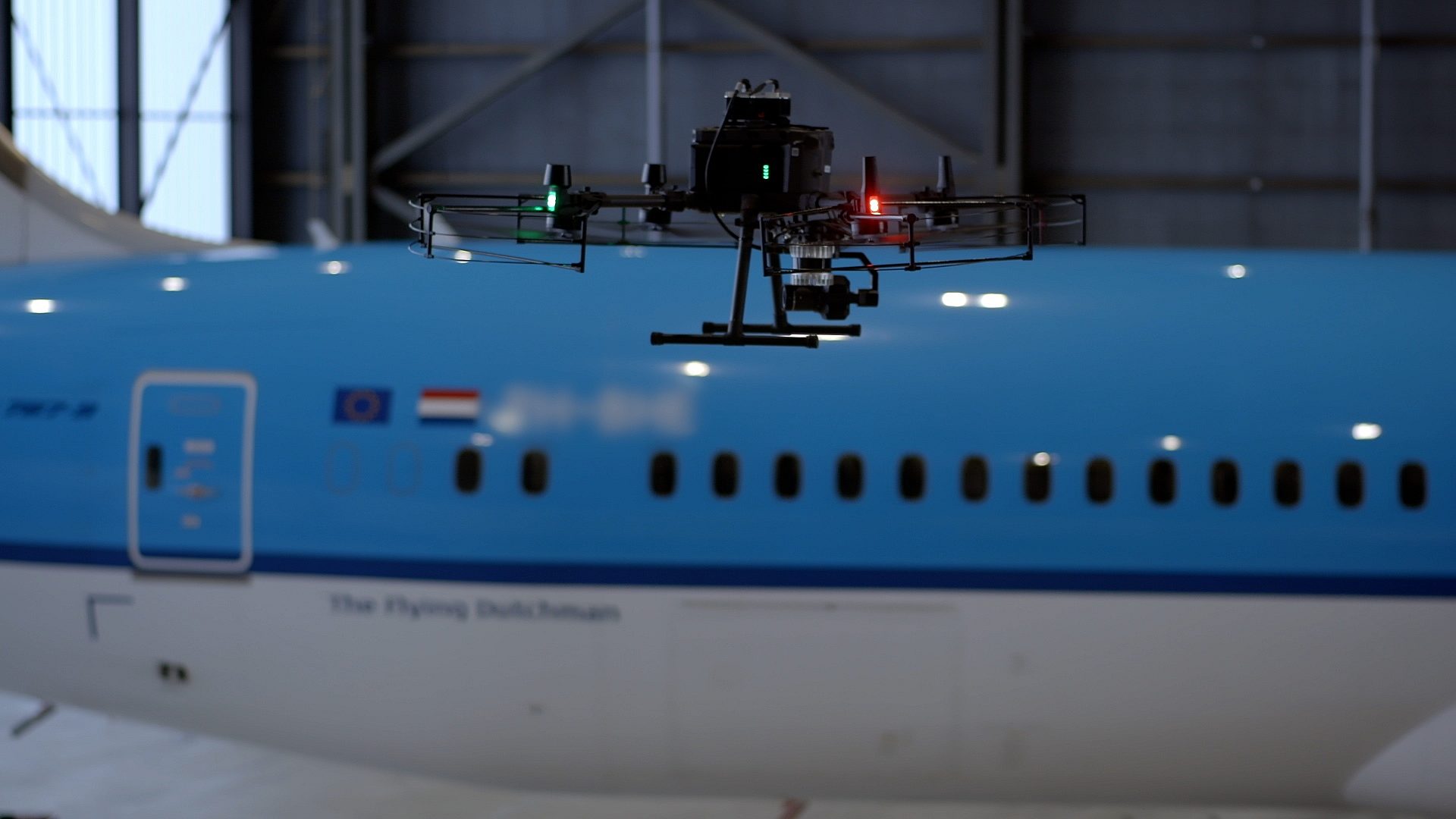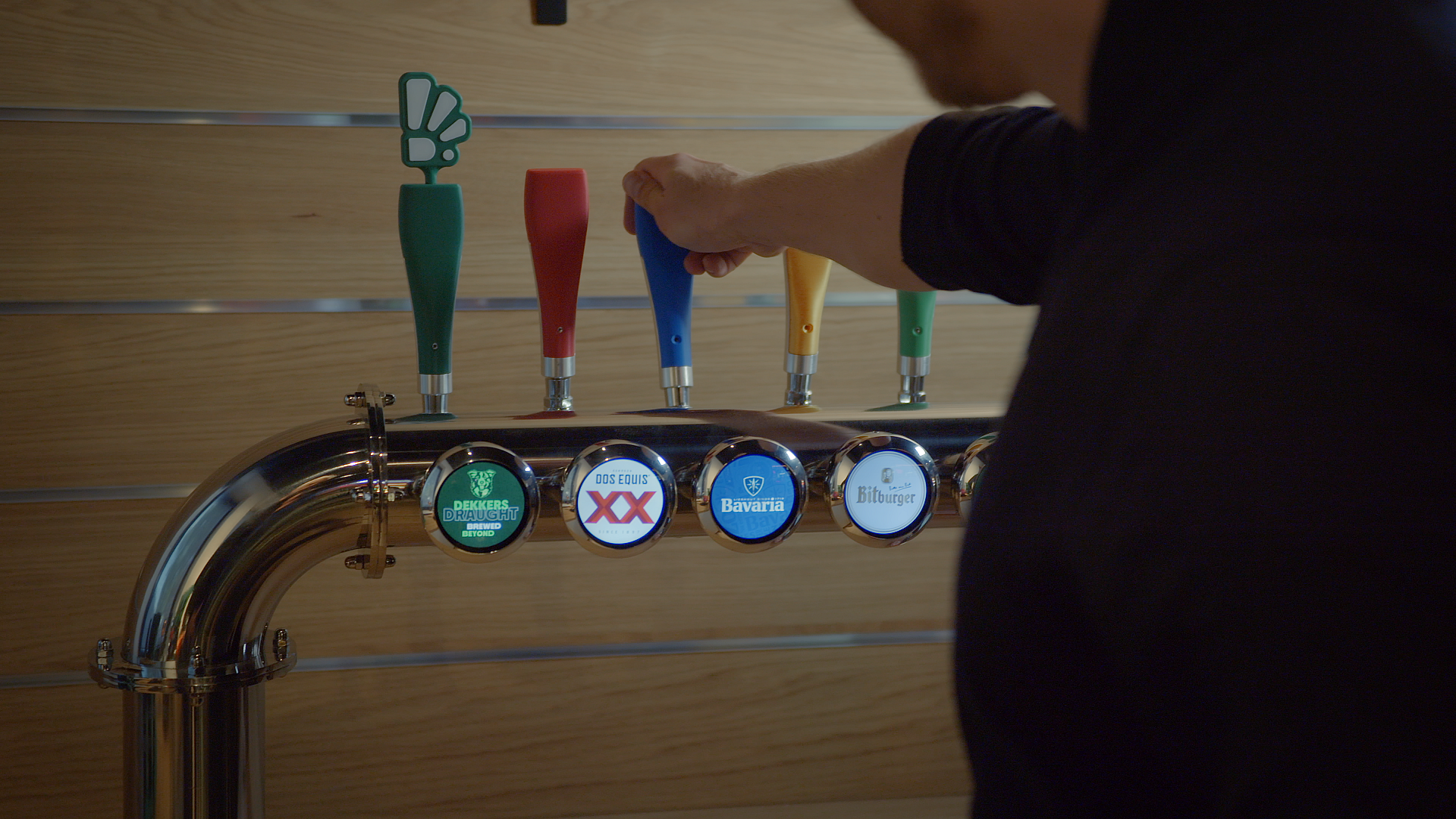Innovating together: KLM inspects aircraft with connected drones
The inspection of aircraft is important, but also time-consuming. KLM is now using drones to detect damages more quickly. The airline is working with Mainblades and KPN on this innovation project. “In the future, each aircraft may have its own drone”, says Bas de Glopper, innovation manager at KLM Engineering & Maintenance.
Mainblades supplies software and technology for visual inspections of aircraft with automated drones. KPN provides the connectivity. Among other things, KLM uses these drones to check aircraft in a hangar for thunderstorm damage. “An aircraft must always be inspected after a lightning strike”, explains De Glopper. “This damage can be the size of a tennis ball, but it can also be as small as a pin head. Looking for a damage with the naked eye, for example, from an aerial platform, takes a lot of time. One inspection takes four men six to eight hours.”
KLM is always looking for ways to organize maintenance more efficiently. “Together with Mainblades, we have developed an automatic drone system that works for every aircraft type”, says the innovation manager. The storm inspections are the first concrete application. “The drone flies autonomously past the aircraft, takes photographs, and displays them on an iPad. Then, an AI system searches for possible damage. By doing this, we can reduce the inspection time to one to two hours.”
Watch our video

How does the system work?
Identifying damage is done with the help of artificial intelligence. “Experienced KLM engineers look at the drone photographs and the suggestions from the Machine Learning software, and we use our special software to feed the results back to the algorithm”, says Michael Sprehe, business development manager at Mainblades. “The algorithm uses this input to better learn and understand what specific damages look like. The analyses support the staff in the decision-making process."
The drone system not only allows for quicker inspections, but also improves the quality of data. “The drone always flies the same path and takes pictures of the same parts of the aircraft”, according to De Glopper. “So the data is more uniform than if we were to take the photographs manually from an aerial platform. This also makes it easier to compare photographs from different inspections. All the data ends up in the Mainblades platform and are easily accessible to anyone with the correct user rights.”
Smart and weatherproof
The drones themselves are equipped with technology that automatically recognizes and avoids objects. “That makes the system very suitable for operational environments such as hangars”, explains Sprehe. KLM eventually wants to deploy the drones outside as well. “Our drones are weatherproof. Now, the aircraft are still towed to a hangar in Schiphol-East for visual inspections, but soon that will no longer be necessary.”
KPN provides the connectivity for the drones, which are deployed all over the world. Sprehe: “The encrypted inspection data that is stored on European servers has to be immediately available in the cloud, also for employees in the office. That requires fast and reliable connectivity. This is also crucial for Mainblades itself. Our developers must have remote access to all drones, for example, to resolve technical challenges. KPN’s SIM cards facilitate this in all the countries where we operate and support 5G, so that we’re ready for the future.”
Infinite applications
The thunderstorm inspection is just one of many applications that KLM is looking at. De Glopper: “Paint damage can occur on the wings of an aircraft because the paint does not adhere well to the composite material. You want to be able to monitor this damage continuously. This is only possible if you can quickly make high-quality recordings of it. That’s why we are now testing the use of drones for inspecting the wings of the Boeing 787.”
There are many more inspections for which a drone can be of help. “There are all kinds of stickers on an aircraft that you can easily check with a drone. We also notice that the maintenance personnel are seeing the advantages. When Mainblades is working with a drone in the hangar, requests often come in. ‘I need to check the Wi-Fi antenna on the aircraft, can you take a photograph with the drone?’ Then, there is no need to get an aerial platform or to climb onto the aircraft.”
The power of an ecosystem
KLM consciously works with innovation partners such as Mainblades and KPN. “We can only exploit the huge potential of drones if we join forces with specialists. We have a lot of knowledge about aircraft maintenance, but we use partnerships for the development of AI systems and the setting up of networks. This eco system is very valuable for KLM. We’re learning from these companies every day, and they’re learning from us. Together, we’re accelerating innovation.”
De Glopper expects that drone inspections will become the norm. “In the aviation industry, it’s all about fleet availability. With the drone, that fleet availability can be increased through rapid drone inspections. The more efficient the maintenance, the more passengers we can transport. I can imagine that in the future, aircraft will be fully inspected at the gate by a drone. Digitization, automation and data become more and more important, also in our field. That's why we see a lot of potential for this technology to aid technicians in their daily work. And maybe every aircraft should just have its own drone travelling with it.”
Want to know more about the possibilities of global connectivity for your company? Feel free to contact our experts.



